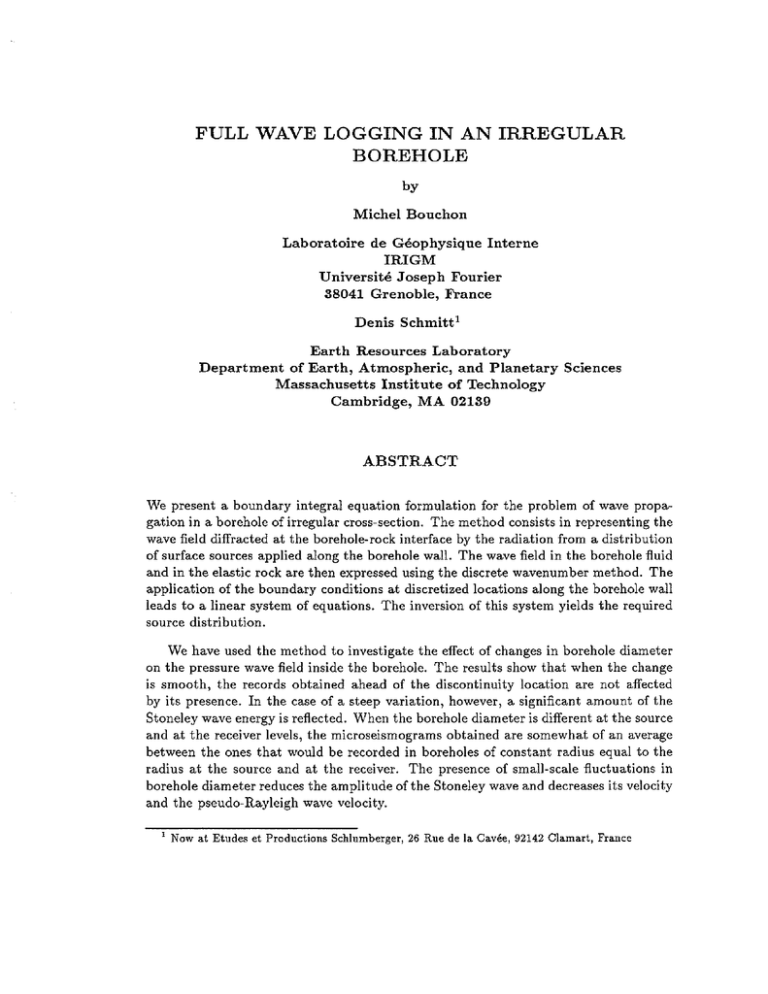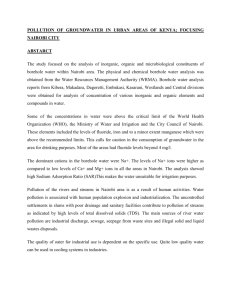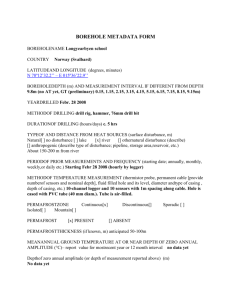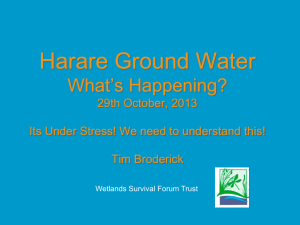FULL WAVE LOGGING IN AN IRREGULAR BOREHOLE
advertisement

FULL WAVE LOGGING IN AN IRREGULAR
BOREHOLE
by
Michel Bouchon
Laboratoire de Geophysique Interne
IRIGM
Universite Joseph Fourier
38041 Grenoble, France
Denis Schmitt 1
Earth Resources Laboratory
Department of Earth, Atmospheric, and Planetary Sciences
Massachusetts Institute of Technology
Cambridge, MA 02139
ABSTRACT
We present a boundary integral equation formulation for the problem of wave propagation in a borehole of irregular cross-section. The method consists in representing the
wave field diffracted at the borehole-rock interface by the radiation from a distribution
of surface sources applied along the borehole wall. The wave field in the borehole fluid
and in the elastic rock are then expressed using the discrete wavenumber method. The
application of the boundary conditions at discretized locations along the borehole wall
leads to a linear system of equations. The inversion of this system yields the required
source distribution.
We have used the method to investigate the effect of changes in borehole diameter
on the pressure wave field inside the borehole. The results show that when the change
is smooth, the records obtained ahead of the discontinuity location are not affected
by its presence. In the case of a steep variation, however, a significant amount of the
Stoneley wave energy is reflected. When the borehole diameter is different at the source
and at the receiver levels, the microseismograms obtained are somewhat of an average
between the ones that would be recorded in boreholes of constant radius equal to the
radius at the source and at the receiver. The presence of small-scale fluctuations in
borehole diameter reduces the amplitude of the Stoneley wave and decreases its velocity
and the pseudo-Rayleigh wave velocity.
1
Now at Etudes et Productions Schlumberger, 26 Rue de la Cavee, 92142 Clamart, France
34
Bouchon and Schmitt
INTRODUCTION
Full wave acoustic logs are made up of a large proportion of waves guided along the
interface between the borehole fluid and the elastic rock. The presence of discontinuities in this wave guide such as the crossing of bed boundaries and fractures strongly
affects the propagation of the waves (Paillet, 1980; Arditty et al., 1984; Paternoster,
1985; Hardin et al., 1987). Stephen et al. (1985) have used finite-difference schemes
to numerically model such configurations. They studied more particularly the presence of washouts and horizontal fissures and showed that their presence greatly affects
Stoneley wave amplitude and waveform.
In the present paper we investigate the effect of changes in borehole radius on the
pressure wave field inside the borehole. We use the discrete wavenumber formulation
applied in cylindrical geometry (Cheng and Toksoz; 1981; Cheng et al., 1982; Tubman
et al., 1984; Schmitt and Bouchon, 1985; Schmitt et al., 1988) and combine it with a
boundary integral equation approach (Bouchon, 1985; Campillo and Bouchon, 1985).
DESCRIPTION OF THE METHOD
The configuration studied consists of a fluid-filled borehole surrounded by an homogeneous elastic formation. The borehole radius is allowed to vary vertically but the
geometry of the well is symmetric with respect to the borehole axis. The source is a
dilatational point located at the center of the borehole. The receivers may be placed
anywhere.
In a cylindrical coordinate system (r, 0, z), centered along the borehole axis, the
steady-state radiation from a source located at (ro,Oo,zo) may be expressed as (e.g.,
Gradshteyn and Rhyzhik, 1965):
= -1
7r
1
00
K o [v(r 2
+ r5 -
.
2rro cos(O - 00 ))21. ]e'k(z-zO)dk
(1)
-00
1
2
with v =
-~]', and where w denotes the angular frequency, '" IS the compressional wave velocity, R is the distance between source and observation point, K o
denotes the modified Bessel function of the second kind of the zeroth order, and the
eiwt time dependence is understood.
[k
Using the Bessel function addition theorem (Watson, 1922) one obtains:
11
=:;;:
00
-00
~ ~n cos n(O - Oo)ln(vro)Kn(vr)e'k(z-zo)
00
.
for r
2: ro
Full Wave Logging in an Irregular Borehole
35
and
for
with ~n = 1
for n = 0, and ~n
modified Bessel functions of order n.
=
T :':: TO
(2)
2 for nolO, where In and K n denote the
For a source located in the middle of the borehole at depth zo, Eq. (2) becomes:
e-iwRfcx
¢=
R
= -1
JOO
7r
.
Ko(vT)e'k(z-zo)dk.
(3)
-00
We now introduce a periodicity in the source-medium configuration along the zaxis. This replaces the integral in Eq. (3) by a discrete summation (Bouchon and Aki,
1977). Eq. (3) then becomes (Cheng and Toksoz, 1981):
00
2
¢= -
L
L
(4)
m=-oo
with k m
length.
= 27rm/ L, V m =
1
(k~ - ~) 2", m
= 0, ±1, ...
and where L is the periodicity
We next discretize the borehole wall at equal interval
We choose ~z such that:
L = N ~z where N is an odd integer,
~z
along the vertical axis.
(5)
and we evaluate the resulting displacement and stress at the discretized points in the
direction normal to the borehole wall. We obtain, denoting by nr,j and nz,j the radial
and vertical components of the normal to the interface at depth Zj:
Un,j
=
tn,j
+ uz,jnz,j
ur,jnr,j
(6)
an,j
with
ur,i
=
2
-L
00
L
vmK1 (VmTj )eik=(zj-zo)
m=-oo
Uz,j
O"rr,i
=
2i
L
00
L
kmKo(VmTj )eik=(zj-zo)
m=-oo
2
2
--pw
L
00
L
m=-oo
!(o( vmrj )eikm(zj-zo)
(7)
36
Bouchon and Schmitt
where p denotes the density.
Applying Huygens' principle, we represent the wavefield diffracted at the borehole
wall by the superposition of the radiation from sources distributed along the surface
of the borehole. The acoustic wavefield reflected inside the borehole is represented
by dilatational sources, while the elastic field transmitted into the surrounding rock
is described by forces acting in directions normal and tangential to the borehole wall.
Because of the z-discretization that we have introduced, these three sets of surface
sources are reduced to three distributions of circular sources.
The radiation from a circular dilatational source of radius ri located at depth Zi is:
1>
f27r
= Jo
e- iwR/ a
R
dlJi, with R
= [(z -
Zi)2
+ (ri cos lJi -
r cos 1J)2
+ (ri sin lJi -
1
rsin 1J)2]2
that is, using Eq. (2):
1> = 2
L:
Ko(vri)Io(vr)eik(z-z;)dk
for r
~ Ti .
(8)
The periodicity in z replaces the integrals in Eqs. (8) by discrete summations, that
IS:
00
1> = 411"
L
L:
I o(V m ri )Ko(V m r )eikm(z-z;)
for r ~ Ti
m=-oo
00
1> = 411"
L
L:
Ko(vm ri)Io(V m r )eikm(z-z;) for z
:S ri .
(9)
m:;;;;;-oo
The radiation from the whole distribution of dilatational sources representing the
diffracted wave field inside the borehole is thus:
1> = 411"
L
N
00
i=O
m=-oo
L: Qi L:
(10)
Full Wave Logging in an Irregular Borehole
37
and where Qi is the intensity of the circular source i of radius ri applied at depth
Zi = iL1z.
However, the discretization in z implies a periodicity in wavenumber space (Bouchon, 1985; Campillo and Bouchon, 1986) so that Eq. (10) becomes:
</>
=
4
2
L
N
M
2: Qi 2:
G",(r;, r)eikm(z-z;)
(11)
m;:;;-M
i;;;;:o
where M is such that N = 2M
+ 1.
The displacement and stress components at the location (rj,zj) of the borehole
wall may thus be written:
4
_2
L
Uz,j
47ri
L
N
M
i;O
m;-M
2: Qi 2:
f
i;O
v m G""l(ri,rj)e ikm (zj-z;)
M
Qi
2:
kmG",(ri,rj)eikm(zj-z;)
(12)
m=-M
arr,j
From these expressions, the displacement and stress norm" I
are readily obtained using Eq. (6).
I"
the borehole wall
Similarly, we must now derive the expressions of the diffracted wavefield in the
elastic formation. The displacement field generated by a steady-state vertical point
force of strength F may be written in the form (e.g., Harkrider, 1964):
U
= _F_ ~ (e-iWR/f3 - e- iWR /",)
r
47rpw2 8r8z
F
Uz = 47rpw2
[8
2
8z2
R
(e-iWR/f3 _ e- iWR /",)
R
+
w 2 e- iWR / f3 ]
f32
R
(13)
where f3 denotes the shear wave velocity. In the case of a horizontal force acting in the
eo
direction, one gets (e.g., Harkrider, 1964; Kurkjian, 1986):
38
U
r
Bouchon and Schmitt
=
F
47fpw2
cos(O-Oo)
F
Uz
= 47fpw2 cos(O -
00 )
[8
e-iWR/(J _ e- iWR /,,)
2
8r 2
R
(
w2 e-iWR/(J]
+ rp
R
8 2 ( e-iwR/(J ~ e- iWR /,,) .
8r8z
(14)
Using Eq. (2) in the relations (13) and (14) and integrating the point force solution
over a circle of radius ri, one obtains for the displacement field radiated by a circular
vertical force of strength Fz,i applied at (ri, Zi) the expressions:
Ur
=
iFz,i
Lpw2
(
~
k m ( Vm G a,l (ri,T ) - 1m G,6,1 (Ti,r )) e ik=(z-Zi)
L..J
m;;:;:-oo
(15)
with, for
and for
r
2::
r ::;
Ti :
Ti :
G(J(ri, r)
I o( 7m ri)Ko(7m r)
G(J,l(ri,r)
=
Iobmri)K1bm r )
G(J(ri, r)
=
K obm r ;)Io(7m r )
-Kobmr;)hbm r )
G(J,l(ri,r)
and where
7m
=
(k m2 _
w2 ) t .
7J"
(
The corresponding expressions for a circular radial force are:
(16)
Full Wave Logging in an Irregular Borehole
39
The expressions of the diffracted displacement field at location (rj, zJ) of the borehole wall are thus:
,
Ur,j
N
Lpw 2
L
1
=
L
m=-M
i=O
+ L;w 2
Uz,j
M
Fz,i
~
Fr,;
LM
N
L w2
L
P
i=O
,
+ Lpw 2
m~m
Fz,i
[::2
(G.a,2(r;,rj) - G",a(r;,rj))
+ ;:G.a,2(r;,rj )]
eikm(zj-z;)
.
[k;,G,,(r;,rj) _,;'G.a(ri,rj)),km(z)-zj)
(17)
m=-M
~.
M
N
L.' = 0
Fr ,;
L
m=-M
From these expressions, the components of the displacement and stress normal n to
the borehole wall and of the stress tangential t to it are readily obtained through the
relations:
Un,j
=
2
(J"rT,jnr,j
tn,i
tt,j
with
+ Uz,jnz,j
2
+ (J"zz,jnz,j
+ 2CTrz,jnr,jnz,i
-(Jrr,jnr,jnz,j + (J"zz,jnr,jnz,j + Urz,j(n~ti
ur,jnr,j
=
_ A (I)ur
I)
r
_ A (I)u r
I)
r
r
r
Ur
)
2 I)u
+ I)u
I)
z + I-' I) z
a rr -
2 I)u
+ Ur + I)uz)
I)
z + I-' I) r
a zz
+
a rz
= I-' (
I)u r
I)z
+
r
z
-
n~,j)
(18)
z
I)uz)
I)r
and where A and I-' are the Lame coefficients.
The boundary conditions at the borehole wall require that the tangential stress is
null and that the normal displacement and the normal stress are continuous. Therefore,
using the expressions that we have derived above for these observables and matching
the boundary conditions at the N discretized depths yield a linear system of equations
where the unknowns are the source strengths Q;, Fz,i, and Fr,;. The inversion of the
system gives the surface source distribution which describes the scattered wavefield
anywhere in the medium.
The calculation is carried out for equally-spaced frequencies spanning the interval
[0 Hz, fm.x] where fm.x is the highest frequency desired. The periodicity L in the
source medium configuration is chosen such that no disturbance from the neighboring
40
Bouchon and Schmitt
sources or from the neighboring diffractors arrives at the receivers in the time window
of interest. Aliasing of the seismograms is avoided by giving to the frequency an
imaginary part equal to Wi = -rr/T where T denotes the length of the time window.
The effect of this imaginary part is later removed from the time domain solution.
RESULTS
Borehole of Smoothly Varying Radius
The first borehole geometry that we consider is depicted in Figure 1a. The borehole
radius varies smoothly from 12cm to 7cm. The fluid wave velocity is 1500m/s and
its density is 19/cm 3 • The formation elastic parameters chosen to represent those of
a limestone rock are a = 3600m/s, (3 = 2300 mis, and p = 2.5g/cm 3 • The source is
located in the widest part of the borehole and emits a Ricker pressure pulse with a peak
frequency of 5kHz. The microseismograms recorded at an array of 30 receivers located
along the borehole axis at distances ranging from 10cm to 3m from the source are
displayed in Figure 2. The calculation is done from 0 to 21kHz. The periodicity length
L is equal to 9m. The value of N is equal to 61 at low frequencies and subsequently
increases according to the criterion lJ.x = 'fluid/3 where ,fluid denotes the wavelength
in the borehole fluid.
The results presented in Figure 2 may be compared with those obtained for boreholes of constant radius equal to 12cm (Figure 3) and 7cm (Figure 4). The comparison
shows that the signals recorded at locations ahead of the radius change are not visibly
affected by it. As the calculation depicted in Figure 3 was performed using reflection
and transmission coefficients at the borehole wall, the good agreement between the
results of Figures 2 and 3 at the first receivers shows the validity of the boundary
integral formulation.
At the receivers located beyond the change in borehole diameter, the microseismogram characteristics are somewhat of an average between those corresponding to
radii of 12 and 7cm. The pseudo-Rayleigh wave excitation is higher than in the case
of the 7cm radius borehole, but not as high as for the larger borehole (Figure 5). The
Stoneley wave amplitude is larger than for the 12cm radius borehole, but is only half
of what is expected for a constant 7cm radius. Although small, the level of P wave
excitation also lies between the levels obtained for boreholes of 12 and 7cm. Using
the reciprocity principle, an exchange of position between the source and the receiver
located 2m from it would result in the same signal. The above observations thus hold
for a configuration where the source is located in the narrowest part of the well and
receivers are spread a few meters away, in the widest part of the borehole.
Full Wave Logging in an Irregular Borehole
41
Effect of Small-Scale Borehole Irregularities
In order to investigate the effect of small-scale borehole irregularities on the propagating wave field, we consider the geometry depicted in Figure lb. The borehole
radius varies continuously between 11 and 13cm. The variation occurs smoothly over
a periodicity length of 50cm. The comparison of the results obtained with those corresponding to the case of a constant 12cm radius (the average radius of the irregular
well) is displayed in Figure 6. The peak frequency of the source is 4kHz. The other
parameters are the same as the ones used in the previous applications.
The two major features of the results are the slight amplitude reduction of the
Stoneley wave and its increased delay time in the presence of radius fluctuations.
Effect of Steep Radius Variation
We now consider the borehole geometry depicted in Figure Ie. As in the configuration
of Figure 1a studied earlier, the radius decreases from a value of 12cm near the source
to 7em. The change, however, now takes place over a lOcm depth interval and occurs
at a distance of 1m from the source. The other parameters are unchanged. The
calculated microseismograms are presented in Figure 7. They correspond to a peak
source spectrum of 3.5kHz chosen to emphasize the Stoneley wave. The steep change
in the borehole cross-section gives rise to a reflected Stoneley wave. The comparison
with the case of a smooth diameter change (Figure 1a) is displayed in Figure 8. It
shows a decrease in amplitude of the Stoneley wave transmitted across the steep radial
discontinuity.
The perfect agreement between the signals recorded at close range for the two
geometries before the arrival of the reflected waves shows the good stability of the
method. Indeed, different values of the periodicity length (L = 7m and L = gm) and
of the number of discretized depths at low frequencies (N = 181 and N = 61) were
used for the two calculations. The smaller depth sampling relied upon at low frequency
in the presence of a steep discontinuity was designed to provide a finer image of the
borehole wall in this case.
CONCLUSION
We have formulated the boundary integration equation-discrete wavenumber representation method in the case of borehole wave propagation. We have used the method
to investigate the effect of variations in the borehole cross-section on the pressure field
inside the borehole. The results obtained show that a smooth variation in borehole
42
I
Bouchon and Schmitt
radius does not affect the records obtained ahead of the discontinuity location, but
that the presence of a steep cross-section discontinuity reflects a significant amount of
the Stoneley wave energy. When the borehole diameter is different at the source and
at the receiver levels, the characteristics of the microseismograms are somewhat of an
average between the characteristics that would be obtained for boreholes of constant
radii equal to the radius at the source and to the radius at the receiver. Finally, the
presence of small-scale irregularities of the borehole wall reduces the amplitude of the
Stoneley wave and decreases its velocity and the velocity of the pseudo-Rayleigh wave.
ACKNOWLEDGEMENTS
This work was supported by the Full Waveform Acoustic Logging Consortium at M.LT.
and by the Societe Nationale Elf Aquitaine (Production).
Full Wave Logging in an Irregular Borehole
43
REFERENCES
Arditty, P.C., Arens, G., and Staron, P., Improvement of formations properties evaluation through the processing and interpretation results of the EVA tool recordings,
54th Ann. Int. Mtg. Soc. Explor. Geophys., Atlanta, Georgia, 1984.
Bouchon, M., A simple, complete numerical solution to the problem of diffraction of
SH waves by an irregular interface, J. Acoust. Soc. Am., 77, 1-5, 1985.
Bouchon, M., and Aki, K., Discrete wavenumber representation of seismic source wave
fields, Bull. Seis. Soc. Am., 67, 259-277, 1977.
Campillo, M., and Bouchon, M., Synthetic SH-seismograms in a laterally varying
medium by the discrete wavenumber method, Geophys. J. Roy. Astr. Soc., 83,
307-317,1985.
Cheng, C.H., and Toksoz, M.N., Elastic wave propagation in a fluid filled borehole and
synthetic acoustic logs, Geophysics, 46, 1042-1053, 1981.
Cheng, C.H., Toksoz, M.N., and Willis, M.E., Determination of in situ attenuation
from full waveform acoustic logs, J. Geophys. Res., 87, 5477-5484, 1982.
Gradshteyn, I.S., and Rhyzhik, I.M., Table of Integrals, Series and Products, Academic
Press, New York, 1965.
Hardin, E.G., Cheng, C.H., Paillet, F.L., and Mendelson, J.D., Fracture characterization by means of attenuation and generation of tube waves in fractured crystalline
rock at Mirror Lake, New Hampshire, J. Geophys. Res., 92,7989-8006, 1987.
Harkrider, D.G., Surface waves in multilayered elastic media, Part I. Rayleigh and
Love waves from buried sources in multilayered half-space, Bull. Seis. Soc. Am.,
54, 627-680, 1964.
Kurkjian, A.L., Theoretical far-field radiation from low-frequency horizontal acoustic
point force in a vertical borehole, Geophysics, 51, 930-939, 1986.
Paillet, F.L., Acoustic propagation in the vicinity of fractures which intersect a fluid
filled borehole, Trans. SPWLA 21st Ann. Logging Symp., Paper DD, 1980.
Paternoster, B., Effects of layer boundaries on full waveform acoustic logs, M.S. Thesis,
Massachusetts Institute of Technology, Cambridge, Massachusetts, 1985.
Schmitt, D.P., and Bouchon, M., Full wave acoustic logging: synthetic microseismograms and frequency wavenumber analysis, Geophysics, 50, 1756-1778, 1985.
Schmitt, D.P., Bouchon, M., and Bonnet, G., Full wave synthetic logs in radially semi-
44
Bouchon and Schmitt
infinite saturated porous media, Geophysics, in press, 1988.
Stephen, R.A., Pardo-Casas, F., and Cheng, C.H., Finite-difference synthetic acoustic
logs, Geophysics, 50, 1588-1609, 1985.
Tubman, K.M., Cheng, C.H., and Toks6z, M.N., Synthetic full-waveform acoustic logs
in cased boreholes, Geophysics, 49, 1051-1059, 1984.
Watson, G.N., A Treatise on the Theory of Bessel Functions, Cambridge University
Press, Cambridge, 1922.
(
Full Wave Logging in an Irregular Borehole
)I(
)I(
)I(
A
B
c
45
50cm
Figure I: Borehole geometries and source-receivers configurations studied. In Figure
la the radius changes sinusoidally from 12cm at an axial distance of 50ern from the
source to a value of 7cm at a distance of 1.50cm. In Figure Ie the same change
occurs between distances of 95cm and 1.05m. In Figure Ib the radius fluctuates
sinusoidally between l1cm and 13cm, with a wavelength of fluctuation of 50cm.
Bouchon and Schmitt
46
0.1
m I
/'
tjl-------------../
Z
;:: I--------------~'(
(f)
~
o
3.0M
r----------------------------~~
O.
1.0
TIME(MS)
Figure 2: Synthetic acoustic logs obtained for the configuration of Figure lao The
source is a Ricker wavelet of 5kHz peak frequency. The origin time is D.lms before
the time of maximum pressure at the source. The direct water pulse is not included.
2.0
47
Full Wave Logging in an Irregular Borehole
o.
0.1
1.0
m
tJ
r-----------~----
Zr-------------------
~r---------------~
~ j----------------~~
Or--------------....::::..
3.0 m
j-
o.
-.:::.
1.0
TlME(MSl
Figure 3: Same as Figure 2 for a borehole of constant radius equal to 12cm.
2.0
48
Bouchon and Schmitt
f\
o
,
f\
0.1
m
2.0
1.0
~ ",rA~~
I/\'/,'vl/ "\
1(1'\...
1/ \/
1/\ v
V,
I
A
'I
\ \
Iv
IV
/'r~
\
\/
w
u
z
<
'\
-,
v
'I
11\
III /V ,(\
I/' J\.... I {\
1'- ~
'I' f\-: 1(\
\.
IJ
1(\ F'---' 1\
,(\
In ~ f\-: f\
'V '\11:;,1
I(f)
~
o
\I
/1\11 ~ "
II '--\ -I "
v:::r
/\ ,--\"\ ~
X \
"St\
A
-u \.
\A
TI
'(\
.-:...V
'1'1
\J
'\1 \
v \
~
";::\
h
(', II " ' \ "
In l /\ \~
-\7 \ /
'n ~
CJ,
VI
\J
"IJ M
V
3.0 m
,
o.
1.0
TIME (MS)
Figure 4: Same as Figure 2 for a borehole of constant radius equal to 7cm.
2.0
49
Full Wave Logging in an Irregular Borehole
0.2
O. 8
m
0.4
0.6
0.8
1.0
1.2
1.4
1.8
1.6
1--_",-,
w
u
Z
::
;:: 1. 5 m 1-----"'--'::."':'ii'.~
m
o
~
~
3. a m I-
- __
.;;;,,~
~.
VOl"""1.oble ,...odiu~
l"""od!us = 12c:m
r'cdtus = fern
o.
0.2
0.4
0.6
0.8
1.0
1.2
1.4
1.6
TIME (MS)
Figure 5: Comparison of the microseismograms obtained for a borehole radius varying
between 12 and 7cm (Figure la) with those corresponding to constant borehole
radii of 12cm and 7cm. The source is a Ricker wavelet of 5kHz peak frequency.
The origin of the time scale is the time of maximum pressure at the source minus
a delay time which is equal to the axial distance divided by the P-wave velocity in
the formation.
1.8
50
Bouchon and Schmitt
o.
0.2
0.4
0.6
0.8
1.0
1.4
1.2
l.8
1.6
I'
1\
1 \
I \
1 \
,
w
< 2.0M
f-
/
\
"
\
\
\ r
\
1,
1 \
I \
1 I
I
\
1
I
\ 1
I
'I
I
U
Z
\
I
I
I
I
I
I
I.
1.0 m
I
I
7
(J)
~
1
0
I
I
\
I
1 I
I \ \ 1
I 1
I I
I \
I
I
3.0 rn
vCr'tobt-o
-----
,...Odo/.U5
=
-
/
1
1
1
I
r'adiu~
I
I
12cm
1
1 1
\ I
\
O.
0.2
0.4
0.6
0.8
1.0
1.2
1.4
1.6
TIME(MS)
Figure 6: Comparison of the microseismograms obtained for the borehole geometry
of Figure 1b with those that would be recorded for a borehole of constant radius
equal to 12cm. The source is a Ricker pressure pulse of 4kHz peak frequency. The
origin of the time scale is lAms before the time of maximum pressure at the source
minus a delay time which is equal to the axial distance divided by the tube wave
velocity (1367m/s).
1.8
Full Wave Logging in an Irregular Borehole
51
O.lm
w
u
z
-<
f-
(f)
~
o
3.0M
f-------------------------------,
O.
1.0
TIME(MS)
Figure 7: Synthetic acoustic logs obtained for the configuration of Figure Ie. The
source is a Ricker pressure pulse of 3.5kHz peak frequency. The origin time is
a.I5ms before the time of maximum pressure at the source.
2.0
52
Bouchon and Schmitt
O.
0.2
0.4
0.6
0.8
1.0
1.2
1.4
1.6
--'-
-'-
-JI
,------,------,-------r-------r-----,------,..-------,----"
0.2m
0.7
m
f------../
--
1.21T1
w
u
z
<
f--
I
(f)
~
0
-\
\
--
1.7 M
"
-
I~\
I
2.2m
--
2.7 m I - - - - - - - - - - - - - - - - - -
~_,__c
5teep rad{u~ variation
5mooth rodiu5 variation
'--
O.
' - -_ _----.J'--_ _----.J
0.2
0.4
0.6
---'
0.8
TIME (MS)
---'
1.0
1.2
1.4
Figure 8: Comparison of the microseismograms obtained for the configurations of
Figures la and lb. The source is a Ricker pressure pulse of 3.5kHz peak frequency.
The origin of the time scale is O.15ms before the time of maximum pressure at
the source minus a delay time which is equal to the axial distance divided by the
P-wave velocity in the formation.
1.6







